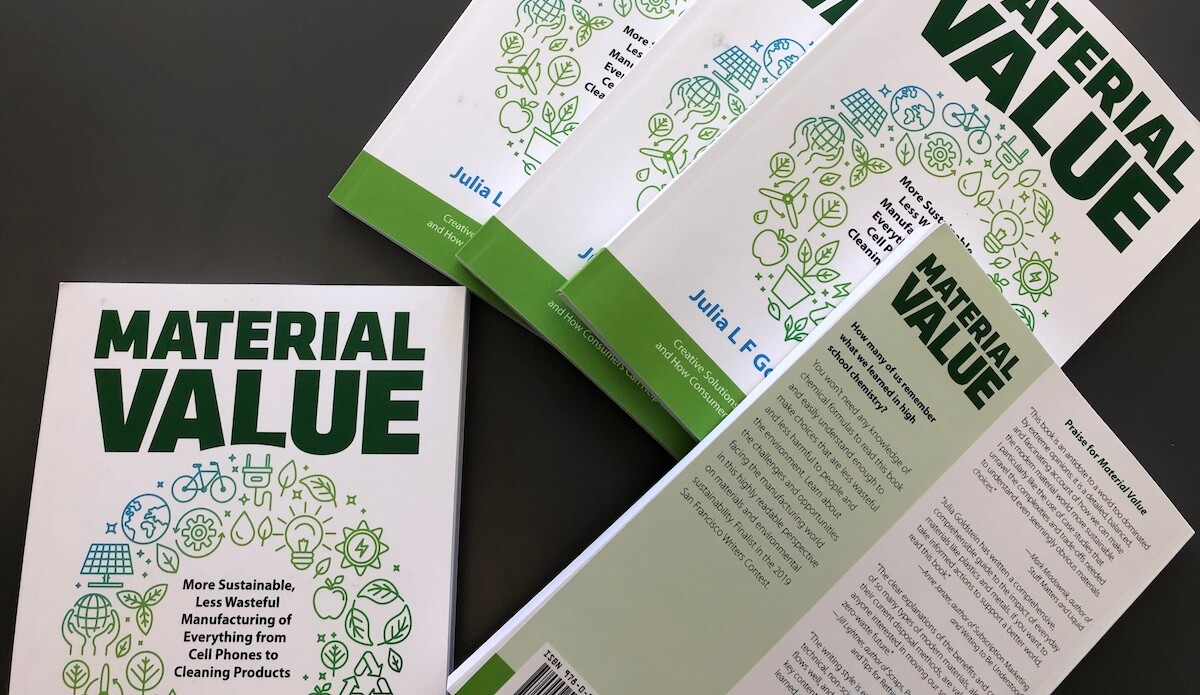
While I’m only four chapters into Material Value written by my colleague and SemiSister, Julia Goldstein, I decided to write the review before I finish reading the book, because Julia will be at ECTC next week in Las Vegas, and I want you all to be able to read the review before so that you can buy her book at the 3D InCites table and talk to her about it. And then we can talk about it in a virtual book group on 3D InCites. This book is THAT IMPORTANT.
The subhead of the book reads More Sustainable, Less Wasteful Manufacturing of Everything from Cell Phones to Cleaning Products. So far, I find it completely fascinating and extremely timely as both consumers and businesses endeavor to address the impact of materials on our environment, and how to incorporate best practices into their homes, lives, and workplaces.
A Scientists’ Perspective
As the title, Material Value, implies, this book is not just about materials that go into semiconductor manufacturing or even electronics: it goes far beyond that. Nor is it written specifically for an engineering and scientific audience. I, the non-engineer, am compelled to read it cover-to-cover. However, engineers and scientists alike will appreciate it, because it is written from the perspective of a materials scientist who understands the complexities involved in changing the status quo.
Julia’s intent is to weigh the pros and cons of materials and their impact on the environment. “I hope to awaken in my readers, a new sense of the importance of materials selection, development, and processing… shed light on the problem and guide towards solutions that make a positive difference,” she writes.
The Intro: A Story in Itself
Don’t even think about skipping over the introduction. It’s a story in and of itself, and provides important context: why this topic and why now? The intro sets the stage, explaining not only the author’s motivation but how the book is organized and what she hopes to achieve with each section.
Beginning in the intro and winding its way throughout the different chapters is Julia’s own journey through the world of materials science that began with her choice of study, a career as an engineer in the semiconductor advanced packaging field, and later as a journalist and freelance writer. (I’ve known Julia since she was a senior technical editor for Advanced Packaging Magazine.
Peppered with technical information and references, historical as well as personal anecdotes and interviews with experts in the field, Julia weaves a compelling story and doesn’t resort to histrionics to convince the reader.
Setting the Stage
Part one sets the stage, beginning with a chapter on chemicals differentiating harmful from helpful, and offering a pragmatic look at how we got where we are. She goes on to examines the removal and replacement of harmful toxins from all perspectives to explain the complexity of the issue.
In chapter two, Julia focuses on the message’s companies send in their handling of “toxic” situations, describing well-documented incidents of corporate negligence, and how to most effectively mitigate the situations to prevent them from re-occurring.
Chapter three discusses materials consumption, the real reasons for reigning in consumption, the challenges involved in doing so, and the concept of zero-waste-to-landfill programs. Our industry gets a nod in this chapter, as Julia calls out Brewer Science as a shining example of a semiconductor materials manufacturer that has pursued and succeeded in achieving its goal of zero waste to landfill in 2015.
Plastics, My Boy, Plastics
Part two shifts into an examination of the materials we use, beginning with a deep dive into one of the environmental conversations du jour: plastics. While reading it, a scene from The Graduate, in which a young Dustin Hoffman is advised to follow a career path in plastics, kept popping into my head. As the chapter heading implies, what was once considered a wonder material has now become the source of global disaster.
Of all the chapters I’ve read so far, this one hit me square-on as a previously oblivious consumer. When I read the sections on the dangers of Teflon and plastic BPA-containing baby bottles, I felt like the world’s worst mother. I’m pretty sure I subjected my children to eggs cooked in a pan with a well-worn Teflon surface, and heated their plastic bottles, cups, and bowls in the microwave, oblivious to the possible leaching of chemicals.
I’m a little nervous to read chapter five, which dives deep into light and heavy metals, including lead and pewter. I’m thinking of those pewter wine goblets my brother and his wife had, and how many times I drank out of them before I learned about RoHS.
That was before my semiconductor industry career and general awareness about materials manufacturing. Had I known better I would have done things differently, just like many of the companies Julia references.
That is why this book is so important. Because once you read it, whether you’re merely a consumer or a CEO of a manufacturing company, you’ll be armed to make different choices.
Rethinking Manufacturing and Next Steps
Parts three and four are where the rubber meets the road. I’m looking forward to reading Julia’s recommendations about how manufacturing companies and consumers alike can tackle these issues in a sustainable way.
If you’re at ECTC 2019 in Las Vegas next week, be sure to stop by the 3D InCites table to chat with Julia about Material Value. You can also order a copy of the book here. Then let’s talk about it. ~ FvT





















